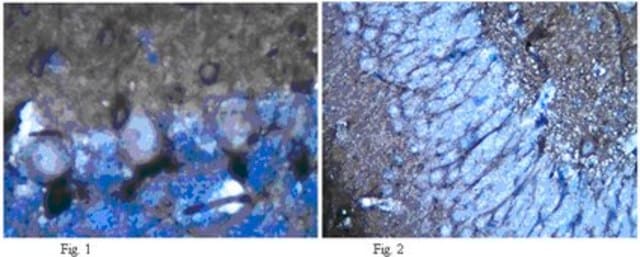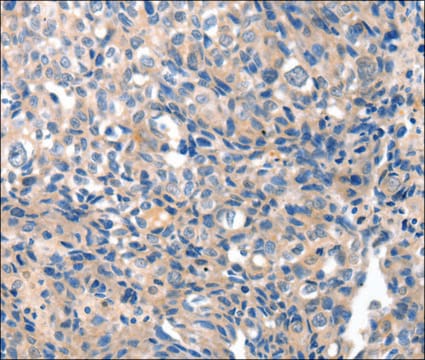MAB5578
Anti-NMDAR2D Antibody
ascites fluid, clone 1G9.39A5, Chemicon®
Sign Into View Organizational & Contract Pricing
All Photos(1)
About This Item
UNSPSC Code:
12352203
eCl@ss:
32160702
NACRES:
NA.41
Recommended Products
biological source
mouse
Quality Level
antibody form
ascites fluid
clone
1G9.39A5, monoclonal
species reactivity
human, mouse, rat, rabbit
manufacturer/tradename
Chemicon®
technique(s)
western blot: suitable
isotype
IgG2b
NCBI accession no.
UniProt accession no.
shipped in
dry ice
target post-translational modification
unmodified
Gene Information
human ... GRIN2D(2906)
Related Categories
Specificity
NMDAR2D, C-terminal. By Western blot the antibody reacts with a weak band at ~145. An additional band at ~75 kDa may be seen depending on sample and antibody concentration used.
Immunogen
Recombinant protein from rat NMDAR2D.
Application
Anti-NMDAR2D Antibody detects level of NMDAR2D & has been published & validated for use in WB.
Research Category
Neuroscience
Neuroscience
Research Sub Category
Neurotransmitters & Receptors
Neurotransmitters & Receptors
Western blot: 1:500-1:1,000 on rat brain lysate.
Optimal working dilutions must be determined by end user.
Optimal working dilutions must be determined by end user.
Physical form
Liquid.
Storage and Stability
Maintain at -20°C in undiluted aliquots for up to 6 months after date of receipt. Avoid repeated freeze/thaw cycles.
Analysis Note
Control
Rat forebrain or cerebellum.
Rat forebrain or cerebellum.
Legal Information
CHEMICON is a registered trademark of Merck KGaA, Darmstadt, Germany
Disclaimer
Unless otherwise stated in our catalog or other company documentation accompanying the product(s), our products are intended for research use only and are not to be used for any other purpose, which includes but is not limited to, unauthorized commercial uses, in vitro diagnostic uses, ex vivo or in vivo therapeutic uses or any type of consumption or application to humans or animals.
Storage Class
10 - Combustible liquids
wgk_germany
WGK 1
flash_point_f
Not applicable
flash_point_c
Not applicable
Certificates of Analysis (COA)
Search for Certificates of Analysis (COA) by entering the products Lot/Batch Number. Lot and Batch Numbers can be found on a product’s label following the words ‘Lot’ or ‘Batch’.
Already Own This Product?
Find documentation for the products that you have recently purchased in the Document Library.
Sharon A Swanger et al.
The Journal of neuroscience : the official journal of the Society for Neuroscience, 35(48), 15971-15983 (2015-12-04)
The GluN2D subunit of the NMDA receptor is prominently expressed in the basal ganglia and associated brainstem nuclei, including the subthalamic nucleus (STN), globus pallidus, striatum, and substantia nigra. However, little is known about how GluN2D-containing NMDA receptors contribute to
Gajanan P Shelkar et al.
Scientific reports, 9(1), 7572-7572 (2019-05-22)
The GluN2C- and GluN2D-containing NMDA receptors are distinct from GluN2A- and GluN2B-containing receptors in many aspects including lower sensitivity to Mg2+ block and lack of desensitization. Recent studies have highlighted the unique contribution of GluN2C and GluN2D subunits in various
H Wang et al.
Neuroscience, 188, 168-181 (2011-05-21)
Untimely activation of nicotinic acetylcholine receptors (nAChRs) by nicotine results in short- and long-term consequences on learning and behavior. In this study, the aim was to determine how prenatal nicotine exposure affects components of glutamatergic signaling in the hippocampus during
Riley E Perszyk et al.
Molecular pharmacology, 90(6), 689-702 (2016-11-03)
N-methyl-d-aspartate receptors (NMDARs) are ionotropic glutamatergic receptors that have been implicated in learning, development, and neuropathological conditions. They are typically composed of GluN1 and GluN2A-D subunits. Whereas a great deal is known about the role of GluN2A- and GluN2B-containing NMDARs
Jeremy S Lum et al.
Journal of psychiatry & neuroscience : JPN, 43(2), 102-110 (2018-02-27)
The nucleus accumbens (NAcc) has been implicated in the pathology and treatment of schizophrenia. Recent postmortem evidence suggests a hyperglutamatergic state in the NAcc. With the present study we aimed to explore possible glutamatergic alterations in the NAcc of a
Our team of scientists has experience in all areas of research including Life Science, Material Science, Chemical Synthesis, Chromatography, Analytical and many others.
Contact Technical Service








